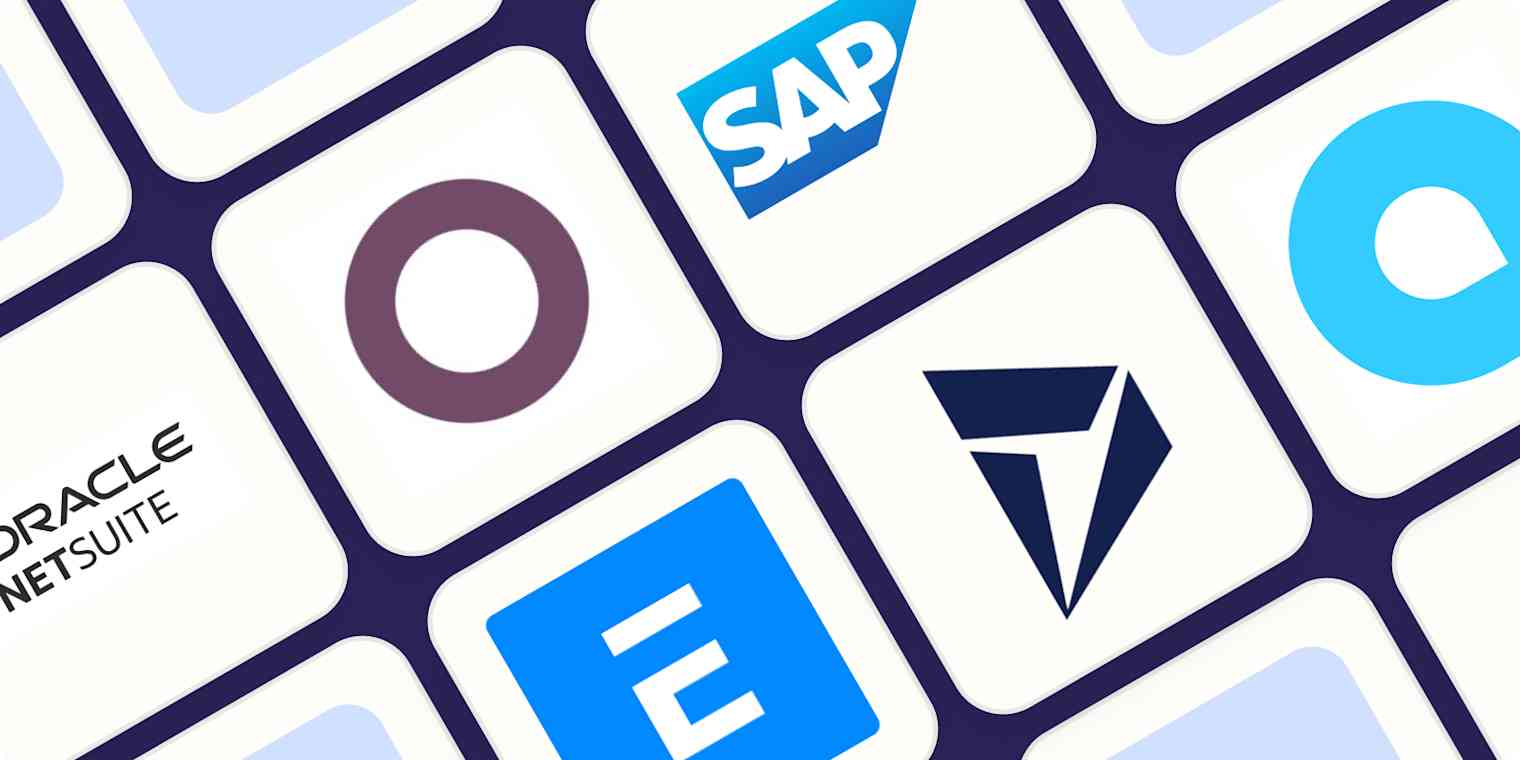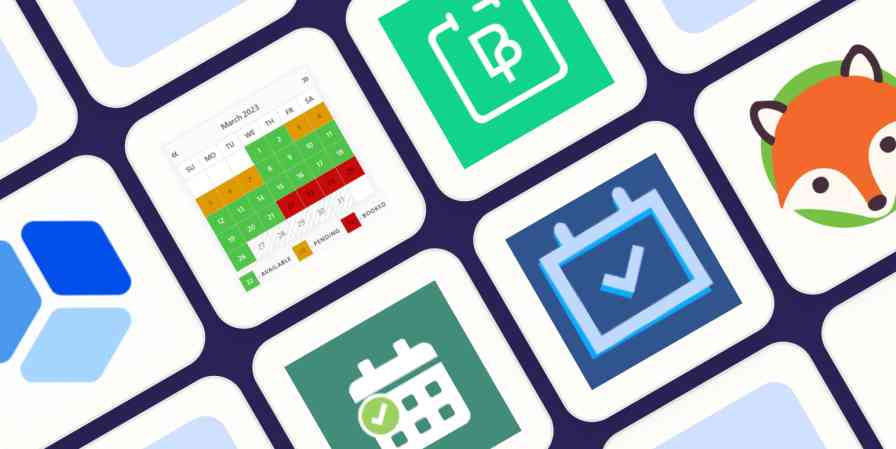So you have a growing company with a bunch of separate departments that all have separate needs. An accounting team that needs to track expenses, an HR team managing sensitive personal information, a marketing team reporting web analytics, and a logistics team doing whatever it is logistics teams do.
You could get one-off apps catered to each department, but rolling them out separately and integrating them across teams sounds like an expensive, inefficient way to silo departments. A better solution is enterprise resource planning (ERP) software.
I did in-depth research on ERP software, spoke to folks who are actually using this software day in and day out, and watched so many demos that I started to dream in ERP. Based on all that, I whittled down a list of the best ERP software out there.
The 8 best ERP software solutions
Oracle NetSuite ERP for the best all-around ERP software
Odoo ERP for custom business processes
SAP S/4HANA for an enterprise-grade solution
ERPNext for the best value ERP
Microsoft Dynamics 365 for dynamic use cases
Acumatica Cloud ERP for the best user experience
Katana for inventory management
Sage Intacct for finance and accounting
What is enterprise resource planning (ERP) software?
ERP software is a comprehensive platform that connects individual teams across an enterprise and gives each user the tools they need to do their jobs efficiently. ERPs can cover a huge range of use cases in virtually any industry, streamlining cross-functional collaboration, preventing data silos, and simplifying workflows in the process.
Here are some common features of ERP software, categorized by use case:
Accounting and finance: tax management, general ledger, financial reporting, transaction data
Inventory and warehousing: inventory tracking, inventory management automation, stock replenishment, wave management, shipping integrations
Orders and fulfillment: invoicing, reporting, payment processing, order tracking, order validation, dropshipping
Supply chain: production data, outstanding order tracking, demand analysis, mobile device tracking
Marketing and sales: client communication, forecasting, customer acquisition cost reporting, workflow management, project analytics
With an ERP system in place, data collected by one department is instantly available to anyone who needs it in any other department.
For example, a merchandise company may use sales orders initiated by its billing team to trigger shipments fulfilled in its warehouse. An ERP system ensures the warehouse manager can see updated order information being processed by the billing manager while the accounting department stays updated on all revenue and expense data.
What makes the best ERP system?
ERP systems have incredibly diverse ranges of utilities and use cases, which makes them tricky to rank objectively. Plus, some have features that cater to niche industries, so a product that's a perfect match for one enterprise may be off the table entirely for another.
To narrow down the playing field, I assessed each ERP software option according to these core criteria:
Range of use cases: ERP software should have wide-ranging capabilities that cover virtually every business process need across an enterprise. Some ERP solutions are really accounting software or logistics platforms with moderate additional functionality, for example, while others are equally powerful tools for all teams.
User experience: This is complex software with a lot of moving parts, so the user experience is extremely important. The structure of the software, how logically designed it is, how similar it is to solutions team members already use, and how fast it runs are all UX considerations.
Scalability: Some ERP software is designed specifically for SMBs, while others are meant for huge enterprises, and some can bridge the gap between the two. This factor gauges how well an ERP software solution can grow with an organization and continue meeting its needs as it grows.
Customization: Not all enterprises operate the same way, so customization potential can be huge for ERP software. This factor assesses how readily the software can be altered to suit the distinct needs of a company and its workflows, processes, and UX preferences.
I want to be transparent that since ERP software is so complex, and few (if any) options offer trial access, it's not really possible for me as an individual to test them all. To make my assessments, I read information posted on product websites, perused real reviews on software sites like G2 and Capterra, analyzed trends in third-party reviews, watched video demos and guides, and asked real users about their experiences with ERP software. Based on all those inputs, I made my picks for the best ERP software.
One more thing: ERP software is highly specialized, and every business has unique needs, so it's super important to do your own research before committing to a solution. These systems aren't exactly plug-and-play, and proper implementation usually requires careful planning and customization.
The best ERP software at a glance
| Best for | Standout feature | Pricing |
|---|---|---|---|
All-around ERP software
| User-friendly access to almost any feature you might need | $$$ | |
Custom business processes | Open source customization capabilities | $$ | |
An enterprise-grade solution | Heavyweight ERP that can handle almost any business scenario | $$$$ | |
The best value | Surprisingly feature-rich free software with open source flexibility | $ | |
Dynamic use cases | Scalable AI integrations | $$$ | |
User experience | Simple interface and good user experience | $$ | |
Inventory management | Robust live inventory management capabilities | $$$ | |
Finance and accounting | Robust accounting and financial solutions, including intelligent general ledger | $$ |
Best all-around ERP software
Oracle NetSuite ERP (Cloud)
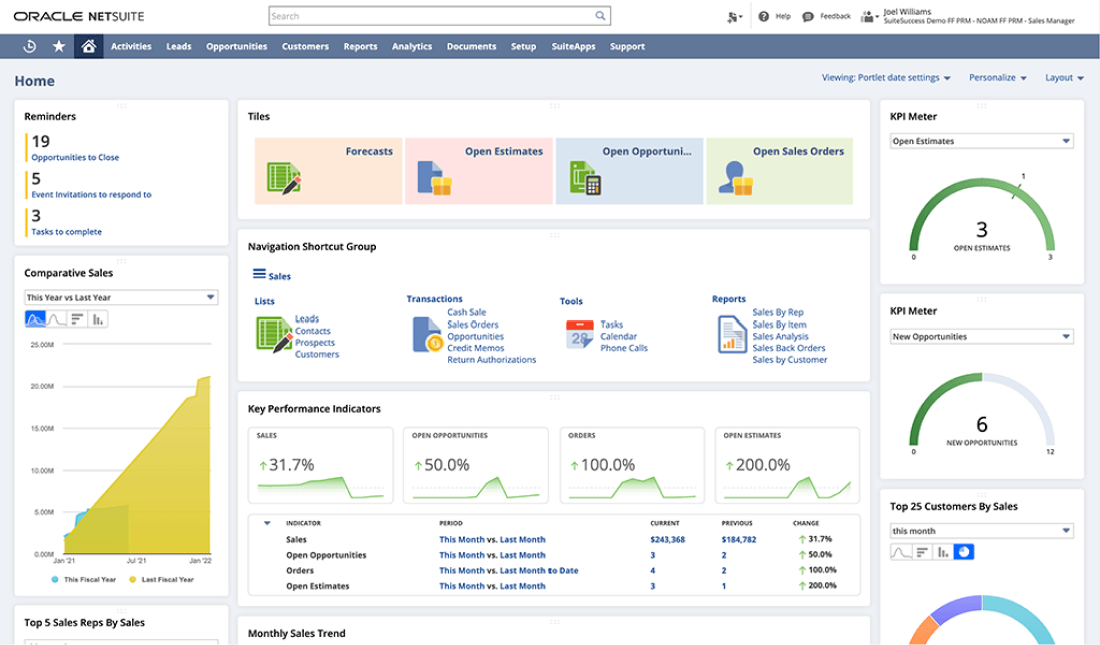
Oracle NetSuite pros:
User-friendly access to many features
Supports multi-currency, multi-language, and tax compliance features
Extensive resources, including user groups, forums, and support from Oracle
Oracle NetSuite cons:
Implementation can be resource-intensive
This should come as a pretty cold take—Oracle is a SaaS juggernaut, and its pioneering ERP product is used by tens of thousands of companies across the globe. NetSuite's LinkedIn profile even claims it became the world's first cloud company in 1998. In some cases, tech this old can grow stagnant and get surpassed by new companies, but Oracle has used its industry standing to improve the NetSuite product year over year.
The Oracle NetSuite ERP gets the nod here for best all-around (and best cloud-based) ERP software because it excels on all fronts and is truly an all-in-one business solution. Its applications run the usual gamut of industries like financial services, consumables, healthcare, and IT, but also include more niche applications like campus bookstores and publishing.
This isn't a jack of all trades, master of none scenario. Oracle NetSuite performs better than most—if not all—competition in really every category. Users point out that its intuitive custom dashboards offer the rare combination of user-friendliness and complexity, whether it's being used to handle accounting, supply chains, procurement, or just about any business use in between. As an example, Jeff Clark, CEO and webmaster of AIToolMall, told me that "NetSuite offers excellent reporting and forecasting capabilities, providing valuable insights for strategic decision-making."
It's tough to find many faults with Oracle NetSuite ERP, but the most commonly cited issues I've seen have to do with implementation and cost. It's not the cheapest option, and rollout can be a little complex and laborious, so it may not be the best choice for smaller organizations with limited internal IT resources.
And with Zapier, you connect NetSuite to thousands of other apps, so you can have better cross-platform visibility, greater data accuracy, and more space for priority work. Learn more about how to automate NetSuite, or get started with one of these pre-made workflows.
Create items in monday.com from new records in NetSuite
Create new posts in Webhooks by Zapier from new records in NetSuite
Update NetSuite records when new or updated rows appear in Google Sheets
Best ERP for custom business processes
Odoo ERP (Cloud, on-premise)

Odoo pros:
Open source customization capabilities
Relatively intuitive and easy to navigate
Large and supportive community for help and resources
Odoo cons:
Customization and troubleshooting can be expensive or cumbersome for small IT teams
Limited functionality in the free version
As an open source solution, Odoo is an easy winner for customization capabilities. With a wide-ranging suite of utilities, a plethora of native apps, open source architecture, and a free community version, Odoo is one of the more distinctive ERP offerings on the market.
ShirtZilla founder Vitaliy Kharitonov raved to me that Odoo's inventory and order processing features make it a "game-changer, streamlining operations and enhancing customer satisfaction." Designed to be a one-stop shop for all business process needs, Odoo includes pre-built apps for everything from customer relationship management (CRM) and point-of-sale (PoS) to time off requesting and expense reporting to publishing and live chats. Whether you're running a shipping business, a medtech company, or a restaurant chain, there's likely already an application that can be deployed or customized to suit every essential task within your organization.
For the tasks that slip between the cracks, Odoo also has a bustling third-party app marketplace. It even integrates readily with lots of popular apps you may already use, like Microsoft Office, Google Drive, and QuickBooks. You can also integrate Odoo with Zapier, which will let you connect Odoo to thousands of other apps too. Here are some examples.
Create leads/opportunities in Odoo ERP Self Hosted from new Jotform submissions
Create leads on Odoo ERP Self Hosted for new Google Ads leads
Create leads/opportunities in Odoo ERP Self Hosted from new emails in Email Parser by Zapier
And if all those options still leave you with an unfulfilled need, Odoo's no-code app studio lets you create custom mobile apps, reports, workflow automations, screens, and more.
The cost of all this flexibility, however, is that open source solutions can be tricky to work with on the back end and expensive to troubleshoot. Beyond the general bug and issue help offered by the included support level, users can buy support packs in hourly blocks that can rack up to five figures pretty quickly. If you've got a skilled IT team, you may not need much support since the included support and community are still really useful, but this could definitely be a deterrent to smaller, less techy organizations.
If your IT team can handle it, Odoo is fairly affordable (and, again, has a rare free ERP offering), well-designed, and incredibly flexible.
Best enterprise ERP
SAP S/4HANA (Cloud, on-premise)
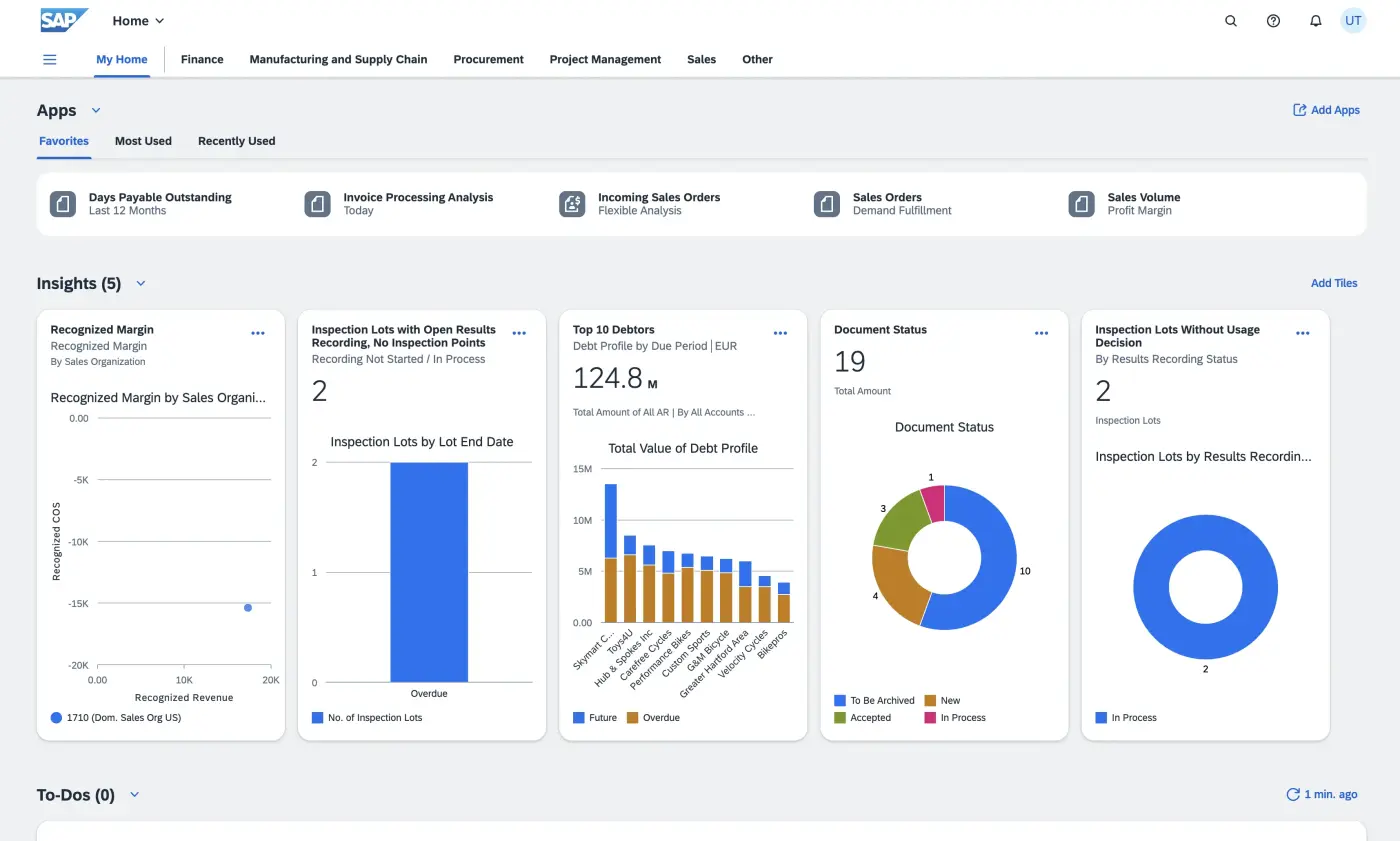
S/4HANA pros:
Heavyweight ERP that can handle almost any business scenario
Advanced reporting and data analysis capabilities
Comprehensive regulatory compliance and localization support for multinational companies
S/4HANA cons:
Complex implementation requiring significant time, resources, and expertise
One of the most expensive ERP solutions on the market
If I had to whittle down all ERP software providers to one Oracle competitor, it'd be SAP. Founded in 1972, parent company SAP SE has been in the business software game even longer than Oracle (1977) and offers five ERP options, including SAP S/4HANA, which puts the "enterprise" in "enterprise resource planning."
Designed specifically for large businesses, S/4HANA (coincidentally, also my Wi-Fi password) is known for its user-friendly interface, scalability, and high-speed database technology.
With over 500 extensions, real-time analytics, a custom software development kit, and both cloud and on-premises deployment options, S/4HANA packs SAP's premium functionality into a tool that can handle just about any business process for virtually any global enterprise. It's impressively customizable, allowing users to build apps, automate menial tasks, create custom dashboards, and really design the ERP ecosystem that works for their unique business and industry.
Some users feel implementation can be overly complex without significant consulting support. If you thought getting your parents on Zoom was a challenge, try explaining to a CFO why the ERP migration is dragging on longer than the Eras Tour. Additionally, the high cost can be prohibitive, and its extensive features may lead to a steep learning curve for end-users.
For small to midsize businesses that want a modular, powerful solution, SAP Business One offers a more accessible entry point with a streamlined feature set tailored to SMB needs. But for large organizations looking for comprehensive ERP software, SAP S/4HANA stands as the best-in-class solution.
Best value ERP
ERPNext (Cloud)
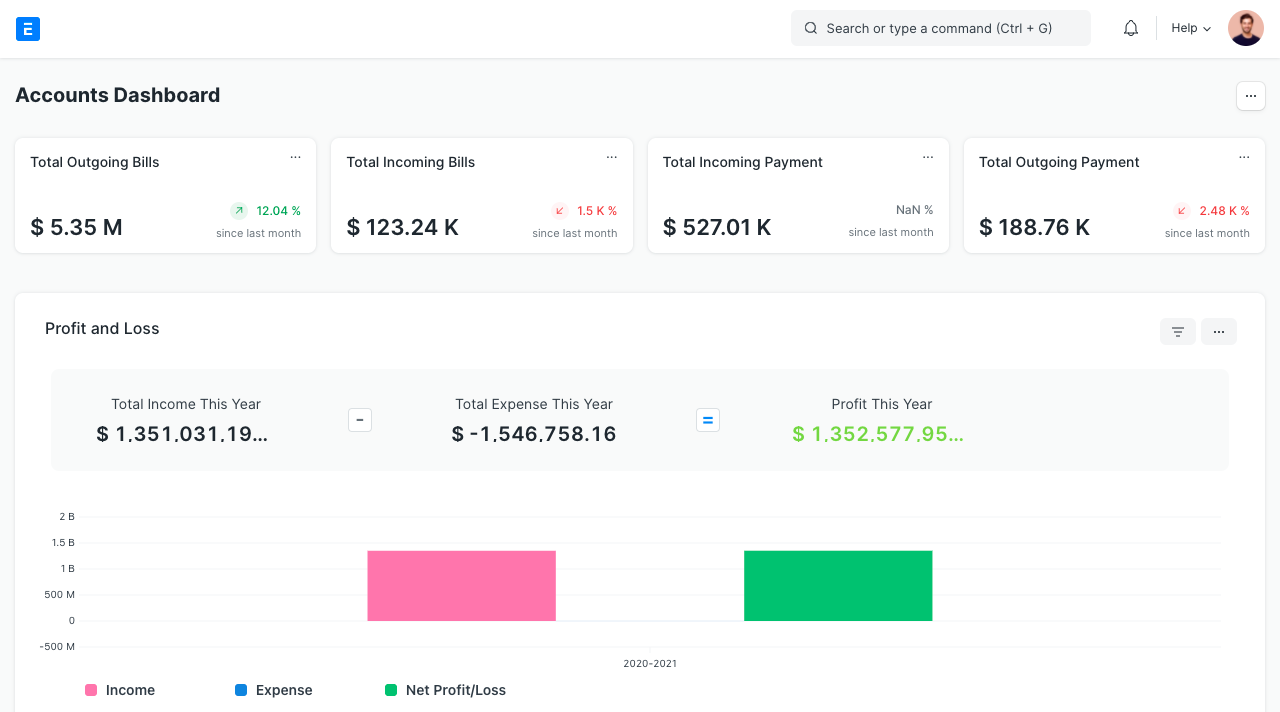
ERPNext pros:
Surprisingly feature-rich free software with open source flexibility
Active community contributing to feature development and support
Minimal upfront costs, especially with self-hosted options
ERPNext cons:
Can require a lot of IT resources to implement and customize
Lacks some of the deeper, enterprise-grade functionalities needed by large companies
A completely free and open source option, ERPNext comes in as a screaming value for users who can install, host, and operate it locally. Paid, hosted options start at just $50 per month for unlimited users, and education and nonprofit organizations may even qualify for additional discounts. It may not have the kind of out-of-the-box utility premium ERP products promise, but it should still be plenty usable for many SMBs.
ERPNext can handle just about every ERP need imaginable, with tools for processes including CRM, help desk, content management, project management, human resources, payroll, order management, and inventory management. Since it's an open source solution designed for low overhead, it just doesn't offer those tools with the kind of simplicity you're likely to get out of the box with a bigger player in the ERP space. To help make up for that, it does offer lots of native integrations with common third parties like WooCommerce, Shopify, Google Drive, Amazon, and Stripe.
For an open source platform, ERPNext has an interface that gets high user marks for its user-friendliness, though its design is predictably a little lo-fi. But the applications themselves, once implemented, are rich. ERPNext offers standout features like multi-currency accounting, auto-generated invoices, lead analysis, Kanban and Gantt views, hierarchical bill of materials, real-time help desk insights, and much more. And when you enter data in one field, related fields automatically update across datasets, ensuring every user in every module accesses the same information.
When it comes time to implement ERPNext, users will find that support and community knowledge are pretty strong. Rollout comes with a consultation call, and there's even a partner ecosystem to help IT teams format the software to their particular needs. Considering this is free software, it can be well worth the time and effort for SMBs with dedicated IT teams looking for an ERP solution that can keep overhead low.
Best ERP for dynamic use cases
Microsoft Dynamics 365 (Cloud, on-premise)
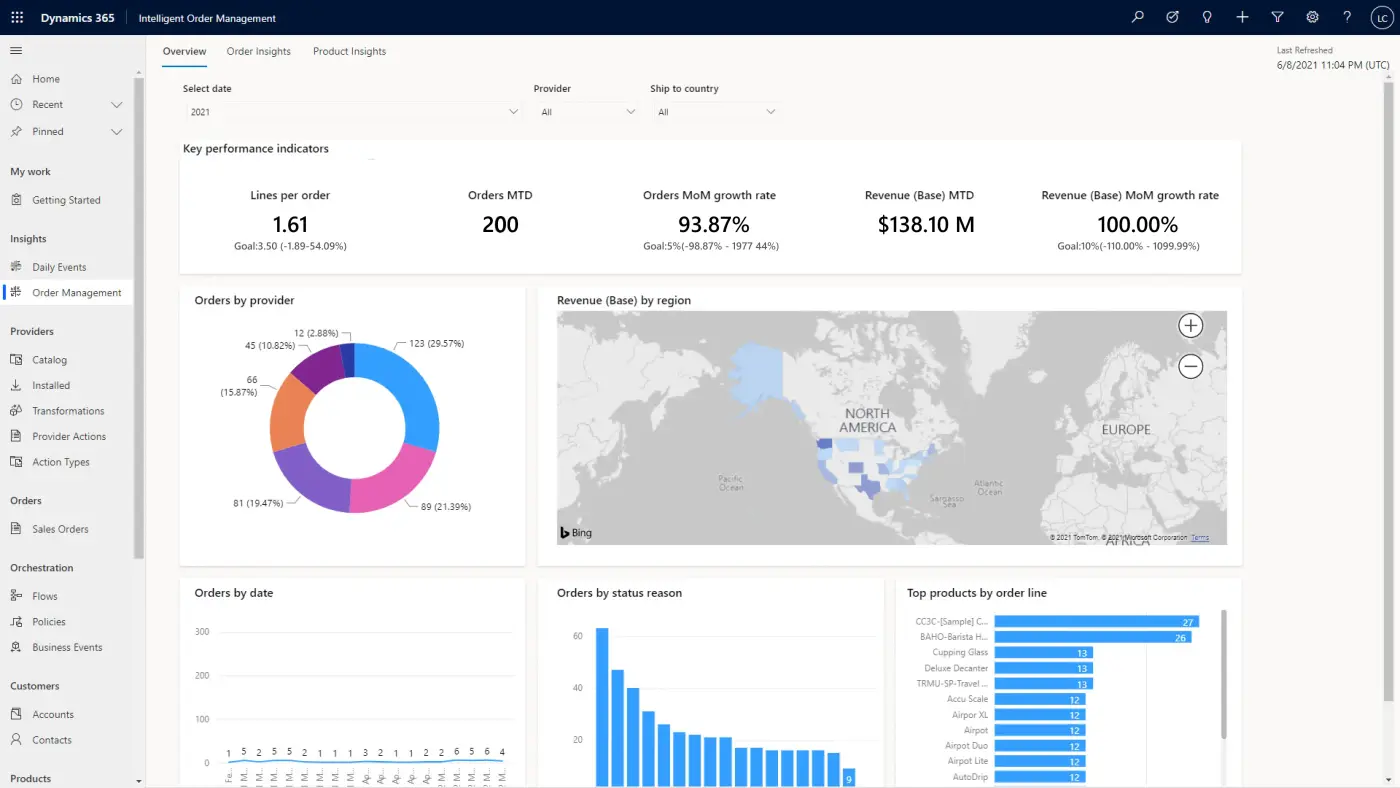
Microsoft Dynamics 365 pros:
Scalable AI integrations
Comprehensive reporting with Power BI integration
Relatively affordable compared to competitors
Microsoft Dynamics 365 cons:
Requires significant hardware resources to run effectively
This wouldn't be a business software list without a Microsoft product, and true to form, its Dynamics 365 ERP offering makes this list for its versatility. Fitness Volt writer and strategist Matthew Magnante told me that its combination of ERP and CRM products "gives companies the ability to see their entire process from beginning to end, automate it, and analyze it in order to improve their operations, engage their customers, and drive growth." Hence, dynamic.
Dynamics seamlessly integrates CRM tools alongside its robust operational tools. This makes it very capable of connecting internal business processes like logistics and custom workflows with customer-centric processes like PoS processes and interaction reporting.
And it gets bonus points here for dynamic AI integration. With its Copilot service, Dynamics helps users cut down on repetitive tasks and reduce human error with AI-driven email creation, intelligent work order filling, issue identification, inventory ordering, automated reporting, and much more.
If there's one drawback I've seen mentioned across the internet about Dynamics 365, it's user experience. Despite the exciting potential of integrated AI, its reporting and forecasting capabilities have been known to be a little clunky and may require third-party integrations for some users. It also comes with pretty hefty resource requirements, so the software itself can be cumbersome for users without top-notch hardware to run it on.
It's also worth noting that, as a Microsoft product, Dynamics 365 is more functional for organizations that already deploy other Microsoft products. It stands to reason that Microsoft prioritizes its own native solutions, so even though there are decent third-party integrations available, if you're used to the MS suite, you'll have a lower learning curve and a simpler time working with the software overall.
Having said that, you can automate Microsoft Dynamics 365 with Zapier to connect it to thousands of apps outside the Microsoft ecosystem. Learn more about how to automate Microsoft Dynamics CRM, or get started with one of these workflows.
Add new Facebook Lead Ad leads to Microsoft Dynamics CRM as contacts
Create Microsoft Dynamics 365 CRM leads for new Google Ads leads
Add Google Ads offline conversions for newly-updated Microsoft Dynamics 365 CRM opportunities
Best ERP for user experience
Acumatica Cloud ERP (Cloud, on-premise)
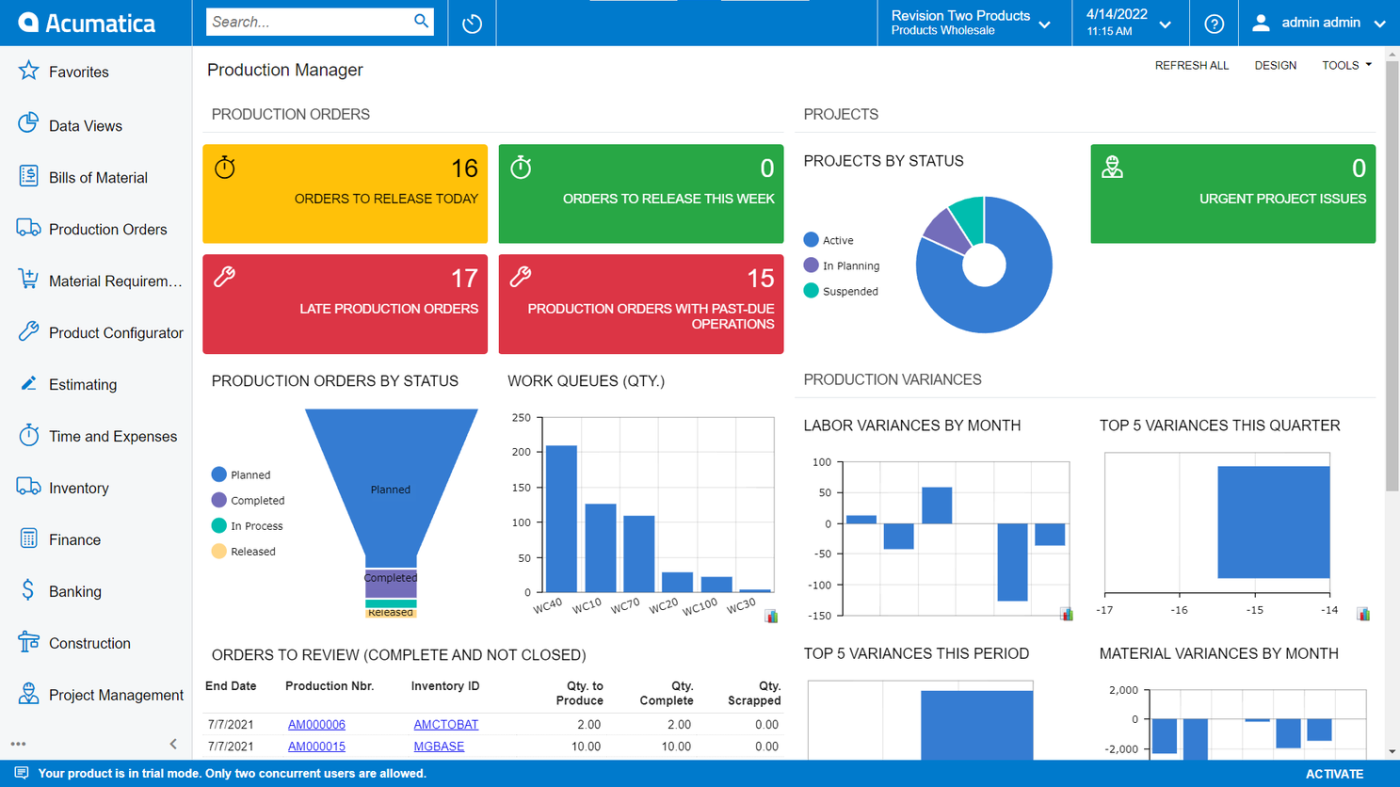
Acumatica Cloud pros:
Simple interface and clean user experience
Offers flexible licensing to suit different needs and budgets
Tailored modules for industries such as construction, distribution, and manufacturing
Acumatica Cloud cons:
Customization can be complex
Fewer third-party integrations compared to some competitors
With software as complicated as an ERP system, sometimes user experience can become underrated, but Acumatica Cloud ERP gets consistently high marks for its ease of use.
Acumatica Cloud ERP has a refreshingly intuitive interface that's easy to onboard—almost to a fault. It's not overly dynamic, but given the complexity of ERP software in general, that's not necessarily a bad thing. Thanks to drag-and-drop boards and workflows, a logically designed and easily customizable dashboard structure, clean reports, no-frills data logging, and a hybrid no-code/low-code ecosystem, new users should be able to adjust pretty readily.
For its relative simplicity, Acumatica Cloud ERP has decent AI and automation functionality. Users can easily set up trigger-based sequences to create customized automated workflows. AI is nicely integrated, with standout features like guided reporting, interactive customer support assistance, and the ability to turn photos of receipts into expense reports.
Acumatica Cloud ERP is positioned mainly as a solution for more traditional ERP fields like construction, manufacturing, and distribution. But since it's readily customizable and has a modular pricing structure, it's not a stretch to use it across consumables, education, hospitality, and other industries that have more recently started flooding the ERP software game.
That said, one of the most common user complaints about the software is how complex customization can be. Fitting the software to less standard business processes and niche industries may be trickier with Acumatica than other ERP providers. Its overall accessibility should more than make up for that shortcoming, though. For example, Bin There Dump That marketing manager Luke Hancock told me that "Acumatica's ability to integrate with other systems and its mobile accessibility are two unique features that enhance its effectiveness as an ERP platform."
Best ERP for inventory management
Katana (Cloud, on-premise)
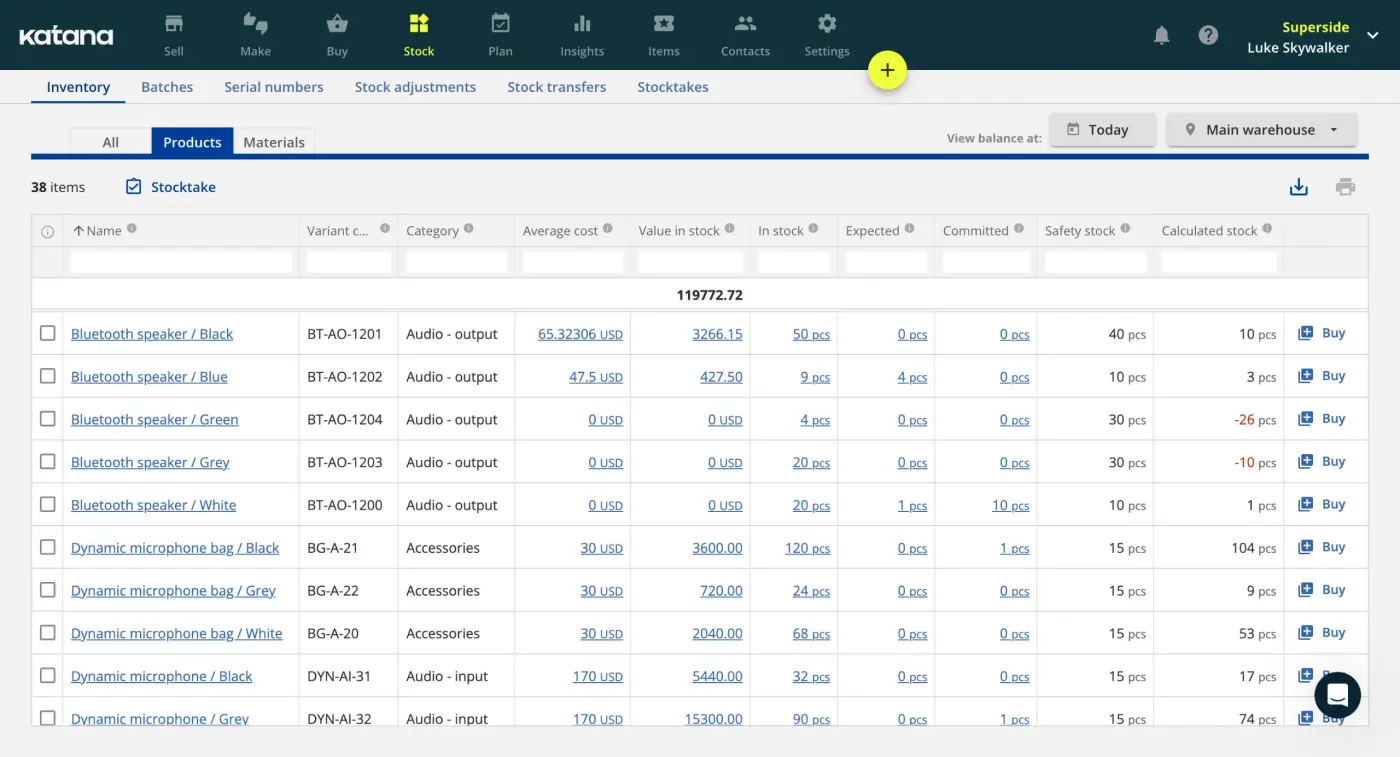
Katana pros:
Robust live inventory management capabilities
Visual and intuitive interface that is easy to use
Integrates with popular eCommerce platforms and marketplaces
Katana cons:
Not ideal for industries that don't rely on physical inventory
Lacks comprehensive functionalities for business areas like accounting and HR
Since Katana is an ERP system explicitly designed for SMBs in the manufacturing industry, it shouldn't come as a huge surprise that it stands out for inventory management.
While it's technically ERP software that can connect processes across organizational departments, Katana may be a little closer to material requirements planning (MRP) software with ERP functionality. For businesses that revolve around physical inventory, some of its standout features include live inventory management tools, omnichannel sales order management, outsourced purchase tracking, automatic stock refactoring, time tracking, scheduling, and task prioritization. Katana makes it simple to issue purchase orders, handle accounting in the cloud, gain insights into expenses, and stay ahead of inventory issues across locations.
That doesn't mean Katana is only useful for pure production or shipping industries. Its open API and no-code ecosystem can help users across industries adapt the software to their needs through custom workflows, data synchronization, app building, and third-party integrations. And Katana's Zapier integration opens you up to automating work across thousands of apps, so you can do things like create sales orders or customers in Katana based on actions taken in other apps. Here are a few examples.
Create Katana sales orders from new rows on Google Sheets
Add Katana customers from new rows on Google Sheets
Create sales orders in Katana from new spreadsheet rows in Google Sheets team drive
Katana even offers generous implementation assistance to help you roll its product out and ensure it's ready to handle your unique needs.
Katana is also, by all accounts, one of the easiest ERP platforms to use and onboard. It also gets high marks for customer service, making it an easy choice for manufacturing and adjacent industries as well as a strong option even for industries that fall outside of the traditional MRP software market.
Best ERP for finance and accounting
Sage Intacct (Cloud, on-premise)
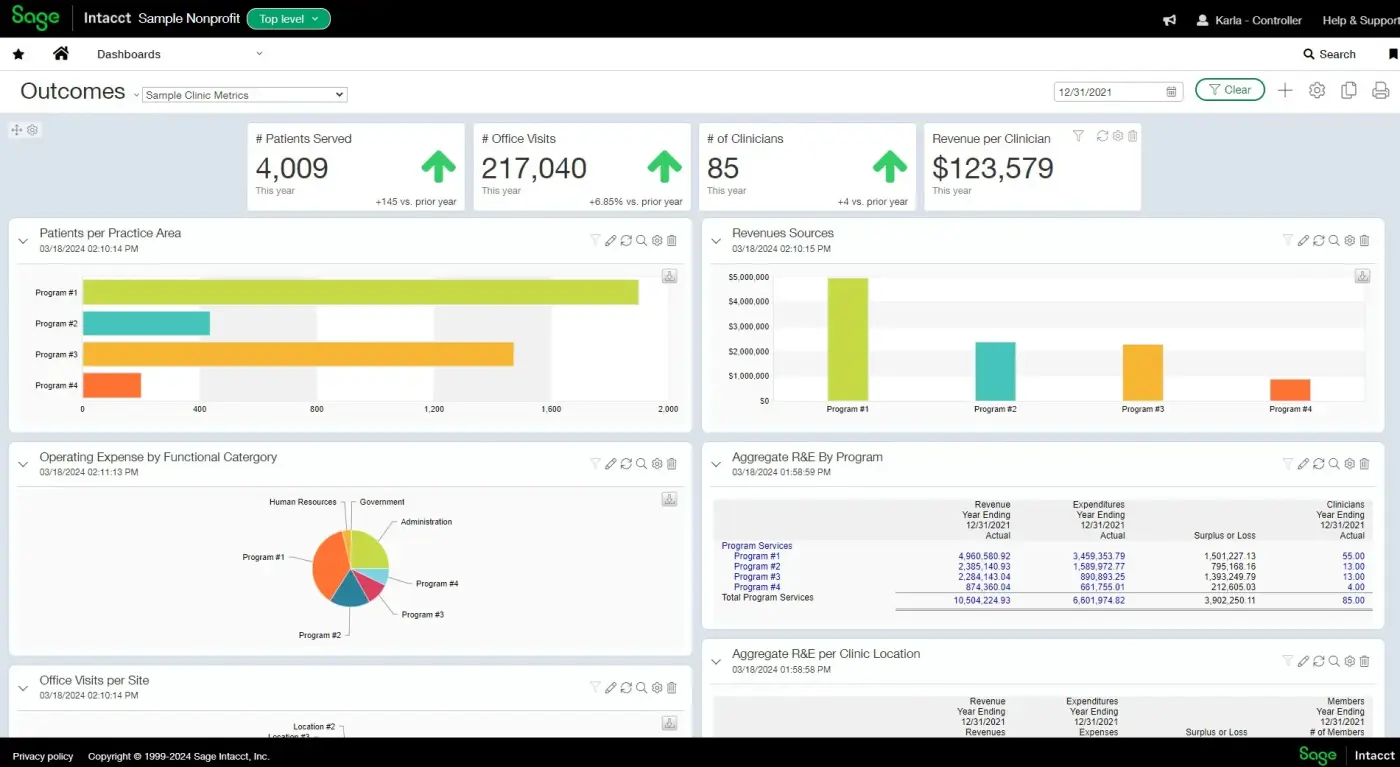
Sage Intacct pros:
Robust accounting and financial solutions, including intelligent general ledger
Offers specialized features for nonprofit organizations
Competitive pricing for midsize businesses and easy to scale
Sage Intacct cons:
Limited native ERP functionality beyond accounting
Dependency on third-party integrations
As an accounting-first ERP solution, Sage Intacct excels at virtually all enterprise-level financial use cases across industries, though it's somewhat limited as ERP software.
Similar to Katana, Sage Intacct is very strong in its intended use case but may not be the most functional choice for every organization. Sage promotes Intacct as ERP software, which is technically true, but it feels a little more like accounting software with just enough ERP-like functionality to classify as an ERP solution. This is especially true where business processes intersect with financial processes, such as sales order processing, inventory tracking, customer reporting, and accounts payable.
Sage Intacct has some of the industry's best financial reporting capabilities. Its custom dashboards are sleek and user-friendly, its intelligent general ledger uses AI to streamline data across separate reports, and its reports can be readily adapted to meet the data needs of just about any industry or stakeholder. It even comes with 150 pre-built financial reports that cut out the need to spend time building new reports or retrofitting reports from previous software. The Custom Report Writer is also a nifty addition, allowing users to create interactive reports to display granular advanced analytics.
When applied beyond accounting, Sage Intacct isn't the most capable ERP system, as it lacks some of the feature-rich applications others have for use cases like sales, customer support, and logistics. Some of its shortcomings can be overcome via more than 350 available third-party integrations, which include tools for features you'd expect from an ERP, like CRM, PoS, eCommerce, tax automation, time tracking, and supply chain management.
For needs not addressed by the app marketplace, the Web Services API can bridge the gap with other integrations. Plus, its Platform Services feature allows users to further customize the software or extend its utility with custom applications and data objects, code-free. This doesn't make Sage Intacct as customizable as open source solutions, but it definitely helps it function like other ERP software.
Sage Intacct also integrates with Zapier, so you can automate tasks across your favorite apps. This allows you to do things like create Sage Intacct contacts from your email list or add tasks from Sage Intacct to your project management tool. Check out some popular pre-built workflows.
Create Tasks in Asana for new Contacts in Sage Intacct
Create New Contacts in Sage Intacct for new Customers in Stripe
Overall, users who want a truly all-in-one ERP solution will probably want to look elsewhere. But for pure accounting capabilities with decent ERP functionality, Sage Intacct is hard to beat, as Solvid CEO Dmytro Spilka told me: "Sage Intacct's advanced accounting services has helped me to manage my own HR services to employees while keeping on top of expenses in a way that ensures a steady long-term cash flow."
Make business processes easier by automating your ERP
This is by no means an exhaustive list—there are dozens of ERP options out there. But whether you choose one of these options or not, even the best ERP software can be enhanced by automation.
Zapier can connect the apps everyone in your organization depends on, bringing no-code automation to every facet of your business. Learn more about how to automate work across departments.
Related reading:
This article was originally published in October 2023. The most recent update, with contributions from Allisa Boulette, was in October 2024.
